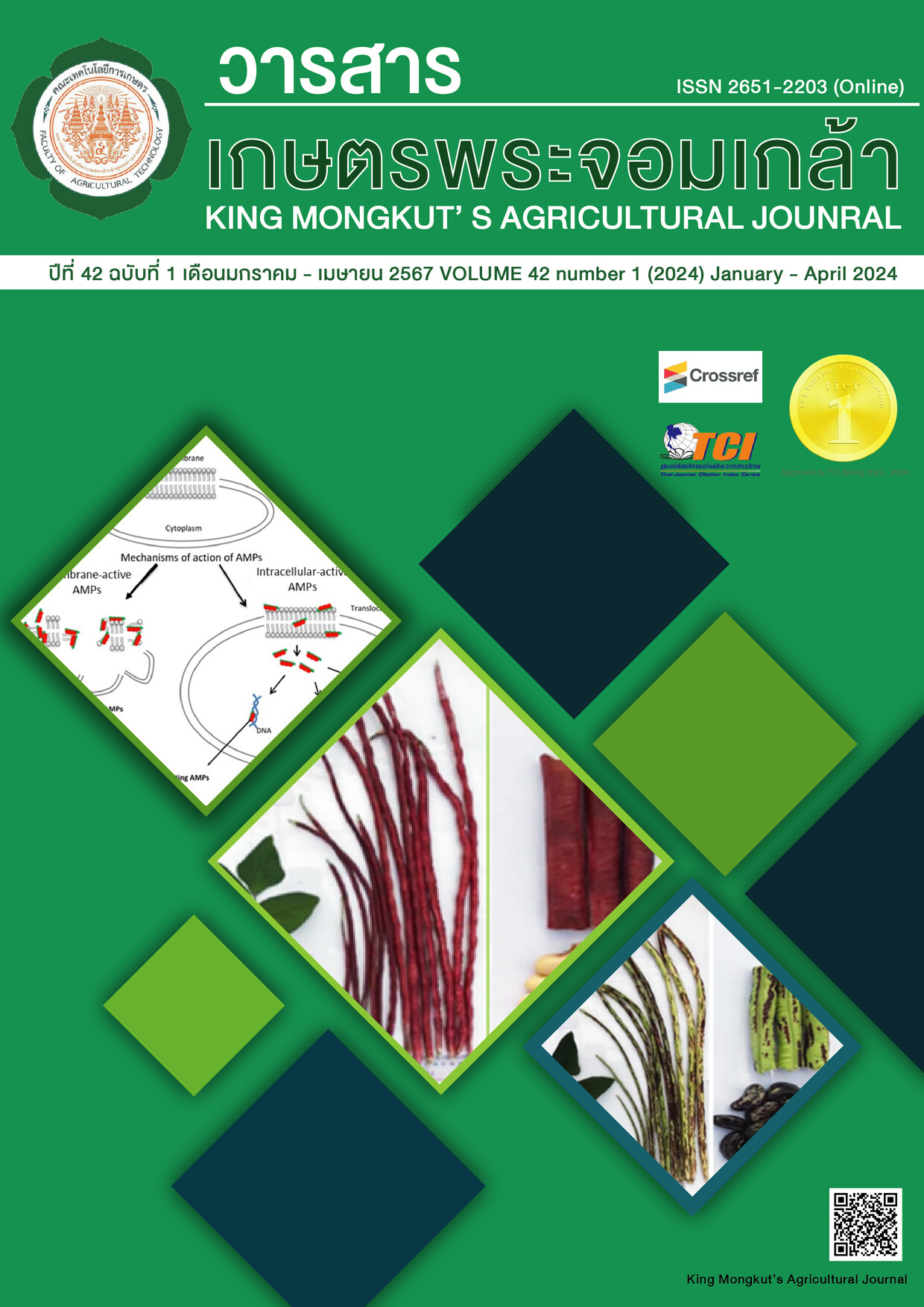ศักยภาพของถั่วฝักยาวสีม่วงพันธุ์ใหม่ภายใต้สภาพอินทรีย์แบบแปลงเปิดเปรียบเทียบกับการปลูกภายใต้ระบบการให้ปุ๋ยเคมีในโรงเรือนพลาสติก
Main Article Content
บทคัดย่อ
ถั่วฝักยาวสีม่วงพันธุ์ “ม่วงราชมงคล” เป็นพันธุ์แท้ที่ปรับปรุงพันธุ์ภายใต้ระบบอินทรีย์ เพื่อทดสอบศักยภาพของพันธุ์จึงวางแผนการทดลองแบบสุ่มสมบูรณ์ในบล็อก จำนวน 4 ซ้ำๆ ละ 20 ต้น โดยมีพันธุ์เปรียบเทียบคือพันธุ์สิรินธรเบอร์ 1 และพันธุ์ลายเสือจักรพันธ์ ระหว่างเดือนกันยายน-พฤศจิกายน พ.ศ. 2563 ภายใต้ระบบการปลูก 2 ระบบคือ 1) การปลูกในระบบอินทรีย์แบบแปลงเปิด และ 2) การปลูกโดยใช้ปุ๋ยเคมีในโรงเรือน พบว่าถั่วฝักยาวพันธุ์ใหม่มีลักษณะแตกต่างจากพันธุ์เปรียบเทียบ ทั้งดอก ผล และเมล็ดพันธุ์ สำหรับการเจริญเติบโตด้านความยาวเถาและจำนวนกิ่งแขนงนั้นมีความแตกต่างทางสถิติทั้งระบบการปลูก พันธุ์ และปฏิกิริยาสัมพันธ์ของระบบปลูกและพันธุ์ ตั้งแต่สัปดาห์ที่ 3-6 หลังปลูก การปลูกโดยใช้ปุ๋ยเคมีในโรงเรือนนั้นถั่วฝักยาวมีความยาวเถาและจำนวนกิ่งมากกว่าระบบอินทรีย์ และพบว่าพันธุ์ม่วงราชมงคลและพันธุ์สิรินธรเบอร์ 1 มีความสูงต้นมากที่สุดทั้งสองระบบปลูก `นอกจากนี้แล้วพบอิทธิพลของระบบปลูกต่อผลผลิต ซึ่งการปลูกโดยใช้ปุ๋ยเคมีในโรงเรือนให้ผลผลิตสูงด้านจำนวนฝักต่อต้น น้ำหนักฝักรวม และน้ำหนักต่อฝัก คือ 34.91 ฝัก/ต้น 815.11 กรัม/ต้น และน้ำหนักฝัก 26.67 กรัม/ฝัก ตามลำดับ อย่างไรก็ตามพันธุ์ม่วงราชมงคลนั้นมีจำนวนฝัก 27.15 ฝัก/ต้น น้ำหนักฝักรวม 611.83 กรัม/ต้น และน้ำหนักฝัก 26.41 กรัม/ฝัก ซึ่งใกล้เคียงกับพันธุ์สิรินธรเบอร์ 1 ทั้งด้านการเจริญเติบโต ผลผลิต ค่าคะแนนความสม่ำเสมอของพันธุ์ และความแข็งแรงของพันธุ์ทั้งระบบอินทรีย์และเคมี
Article Details

อนุญาตภายใต้เงื่อนไข Creative Commons Attribution-NonCommercial-NoDerivatives 4.0 International License.
วารสารเกษตรพระจอมเกล้า
เอกสารอ้างอิง
B da Cunha, A. L., Chaves, F. C. M., Kano, C., Braga, I. G., & R de Oliveira, M. (2020). Nutrient uptake rate for yardlong bean. Horticulfura Brasileira, 38, 175-184.
Chanapan, D. & Benchasri, S. (2015). Seed germination test of 43 varieties of yardlong bean and cowpea. Khon Kaen Agriculture Journal, 43(1), 863-868. (in Thai).
Chanapan, D., Benchasri, S., Simla, S., Siritrakulsak, P., & Sanputawong, S. (2016). Comparison of some responses on yardlong bean and cowpea under two production system. Songklanakarin Journal of Plant Science, 3(Specciall III), 1-9. (in Thai).
Department of Internal Trade. (2020). Organic Product Prices. Retrieved from: https://agri.dit.go.th/index.php/doc_file_view/34. (in Thai).
Department of Agricultural Extension. (2020). Agricultural Production Information System. Retrieved from: https://production.
doae.go.th/service/data-state-product/index?. (in Thai).
Ha, T. J., Lee, M. H., Park, C. H., Pae, S. B., Shim, K. B., Ko, J. M., Shin, S. O., Baek, I. Y., & Park, K. Y. (2010). Identification and characterization of anthocyanins in yard-long beans (Vigna unguiculata ssp. sesquipedalis L.) by high-performance liquid chromatography with diode array detection and electrospray lonization2mass spectrometry (HPLC-DAD-ESI/MS) analysis. Journal of Agricultural and Food Chemistry, 58, 2571-2576.
Khamsee, Y., Tancho, A., Wicharatana, C., Saengyot, S., Thonnalak, T., Bunmark, J., & Chaiwet, W. (2018). Maejo organic agriculture. The Office of Agricultural Research and Extension Maejo University, Maejo University. (in Thai).
Knowledge Base Maejo University. (2020). Plant and animal varieties database, Maejo University. Retrieved from: https://researchex.mju.ac.th/dbplant/index.php/horticulture/vegetable. (in Thai).
Liaotrakoon, W., Liaotrakoon, V., Peanleangchep, P., & Duamkhanmanee, R. (2020). Detection of organophosphate and carbamate pesticide residues in fresh vegetables in Phra Nakhon Si Ayutthaya Province and effectiveness of washing methods on pesticide residues in Kale. King Mongkut's Agricultural Journal, 38(1), 131-138. (in Thai).
Poophalee, T., Wongwattanasathien, O., Arparsrithongsakul, S., & Supuntee, M. (2016). Prevalence of pesticide residues in vegetables from markets and supermarkets in Muang District, Maha Sarakham Province. Thai Journal of Pharmacy Practice, 8(2), 399-409. (in Thai).
Phaengsai, P., Noorinrum, N., & Chutthasing, A. (2018). Varietal Trial in Yardlong Bean Under Open Field in Organic Farming. Bachelor of Science (Special problem project in Plant Science). Rajamangala University of Technology Isan. (in Thai).
Prasopsuk, J., Saisuphan, P., & Srisawangwong, W. (2014). Analysis of pesticide residues in vegetables and fruits for the certification of Good Agricultural Practice in upper Northeast Thailand. Khon Kaen Agriculture Journal, 42 (2), 430-439. (in Thai).
Sanyapueng, S., & Lauprasert, P. (2017). Reduction of methomyl insecticide in yardlong bean by soaking with crude extracts of Thumbergia laurifolia (Linnaeus) and Tiliacora triandra (Colebr) Diels. KKU Journal for Public Health Research, 10(10), 38-46. (in Thai).
Sinsiri, N., & Sinsiri, W. (2012). Standard yield trials for cowpea development to the new variety (MSU2). Khon Kaen Agriculture Journal, 42(2), 53-58. (in Thai).
Srinives, P., & Chatwachirawong, P. (2005). Quantitative Genetics with Application to Plant Breeding. Office of the University Library, Kasetsart University. (in Thai).
Sriwattanapong, S. (2010). Plant Breeding. Office of the University Library, Kasetsart University. (in Thai).
Benchasri, S., & Bairaman, B. (2010). Evaluation of yield, yield components and consumers’ satisfaction towards yardlong bean and cowpea in agricultural organic system. Bulgarian Journal of Agricultural Science, 16(6), 705-712.
Kongjaimun, A., Kaga, A., Tomooka, N., Somta, P., Vaughan, D. A., & Srinives, P. (2012). The genetics of domestication of yardlong bean, Vigna unguiculata (L.) Walp. ssp. unguiculata cr.-gr.¬ sesquipedalis. Annals of Botany, 109, 1185-1200.
Lestari, M. W., Kuswanto, Wardiati, T., & Widorentno, W. (2015). Morphological characteristic of purple long yard bean cultivars and their tolerance to drought stress. Journal of Degraded and Mining Lands Management, 2(2), 281-288.
Maghirang, R., Brulla, M. E., Rodulfo, G., Madrid, I. J., & Bartolome, C. P. (2017). Organic plant breeding: a key to improved vegetable yield and safe food. Horticulturae, 3(4), 1-8.
National Plant Genetic Resources Laboratory. (2018). NPGRL Yardlong Bean Descriptor List. Retrieved from:https://www.genesys-pgr.org/descriptorlists/a3573fc4-fd60-4152-829c-c5d304e1dbb6.
Nuijten, E., Messmer, M. M., & Lammerts van Bueren, E. T. (2017). Concepts and strategies of organic plant breeding in light of novel breeding techniques. Sustainability, 9(18), 1-19.
Organic Agriculture Certification Thailand. (2019). Certification Alliance Organic Standard Version 1.0 06 Nov 2019. Retrieved from: http://actorganic-cert.or.th/wp-content/uploads/2020/02/CertAll_Std_v-1.0.pdf. (in Thai).
Pandey, S., Shrestha, S. L., Gautam, I. P., Dhakal, M., & Sapkota, S. (2020). Evaluation of yardlong bean (Vigna unguiculata ssp. sesquipedalis) genotypes for commercial production in the Central Mid Hills Region of Nepal. Nepalese Horticulture, 14, 43-47.
Ullah, H., Sarfraz, M., Muteen, A., Umar, A., Khan, M. U., Nawaz, H., Bashir, M., Sohail, A., Luqman, M., Rasheed, A., Ulfat, Z., Ullah, A., & Khan, M. S., (2023). Natural and processed organic fertilizer. BIOMEDICAL Journal of Scientific & Technical Research, 49(4), 40852-40857.
White, R., & Connolly, B. (2011). Breeding Organic Vegetables; A Step-By-Step Guide for Growers. Northeast Organic Farming Association of New York, Inc.
Zdravkovic, J., Pavlovic, N., Girek, Z., Zdravkovic, M., & Cvikic, D. (2010). Characteristics important for organic breeding of
vegetable crops. Genetika, 42(2), 223-233.


